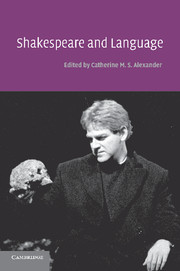Book contents
- Frontmatter
- Contents
- List of contributors
- Editor's note
- 1 Shakespeare and language: an introduction
- 2 Shakespeare's language and the language of Shakespeare's time
- 3 The foundations of Elizabethan language
- 4 Shakespeare's talking animals
- 5 Some functions of Shakespearian word-formation
- 6 Shakespeare and the tune of the time
- 7 Shakespeare's Romeo and Juliet: the places of invention
- 8 Shakespeare's thematic modes of speech: Richard II to Henry V
- 9 Hamlet and the power of words
- 10 The art of the comic duologue in three plays by Shakespeare
- 11 Hamlet's ear
- 12 ‘Voice potential’: language and symbolic capital in Othello
- 13 The aesthetics of mutilation in Titus Andronicus
- 14 ‘Time for such a word’: verbal echoing in Macbeth
- 15 Household words: Macbeth and the failure of spectacle
- 16 Late Shakespeare: style and the sexes
- Index
8 - Shakespeare's thematic modes of speech: Richard II to Henry V
Published online by Cambridge University Press: 15 December 2009
- Frontmatter
- Contents
- List of contributors
- Editor's note
- 1 Shakespeare and language: an introduction
- 2 Shakespeare's language and the language of Shakespeare's time
- 3 The foundations of Elizabethan language
- 4 Shakespeare's talking animals
- 5 Some functions of Shakespearian word-formation
- 6 Shakespeare and the tune of the time
- 7 Shakespeare's Romeo and Juliet: the places of invention
- 8 Shakespeare's thematic modes of speech: Richard II to Henry V
- 9 Hamlet and the power of words
- 10 The art of the comic duologue in three plays by Shakespeare
- 11 Hamlet's ear
- 12 ‘Voice potential’: language and symbolic capital in Othello
- 13 The aesthetics of mutilation in Titus Andronicus
- 14 ‘Time for such a word’: verbal echoing in Macbeth
- 15 Household words: Macbeth and the failure of spectacle
- 16 Late Shakespeare: style and the sexes
- Index
Summary
Just as Shakespeare's characters in a given play tend to use the same words and images, they also tend to use the same ‘modes’ of speech. For instance, Hamlet, one of the few plays in which this characteristic has been noted, is full of questions. Not all of its speeches take the form of questions, of course, or even most of them; nor is questioning the play's only recurring mode of speech, may of the characters being equally inclined toward lengthy admonition. Yet the ‘interrogative mood’ the questions create does make a contribution of thematic importance to the tone and meaning of the play. The same can be said, I believe, of comparable modes of speech in many – perhaps all – of Shakespeare's plays. As a start toward testing this belief, I should like to look at Richard II, 1 Henry IV, 2 Henry IV, and Henry V.
The central mode of speech in Richard II is that of denunciation. Of the four plays, this is the only one which draws its modes to a large extent from its sources. For the most part, Shakespeare intensifies the denunciations he finds in Hall and Holinshed. Where, for instance, in Holinshed York simply ‘delivered the indenture’ to the king which exposed his son's plot, in the play he inveighs repeatedly against the ‘villain’ and ‘traitor’ (5.2. and iii).
- Type
- Chapter
- Information
- Shakespeare and Language , pp. 139 - 150Publisher: Cambridge University PressPrint publication year: 2004



